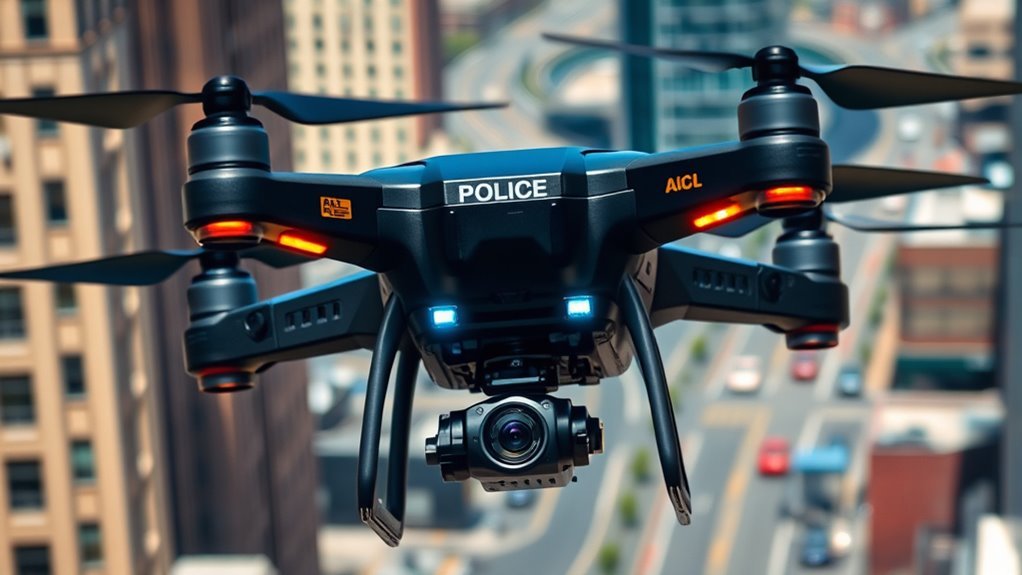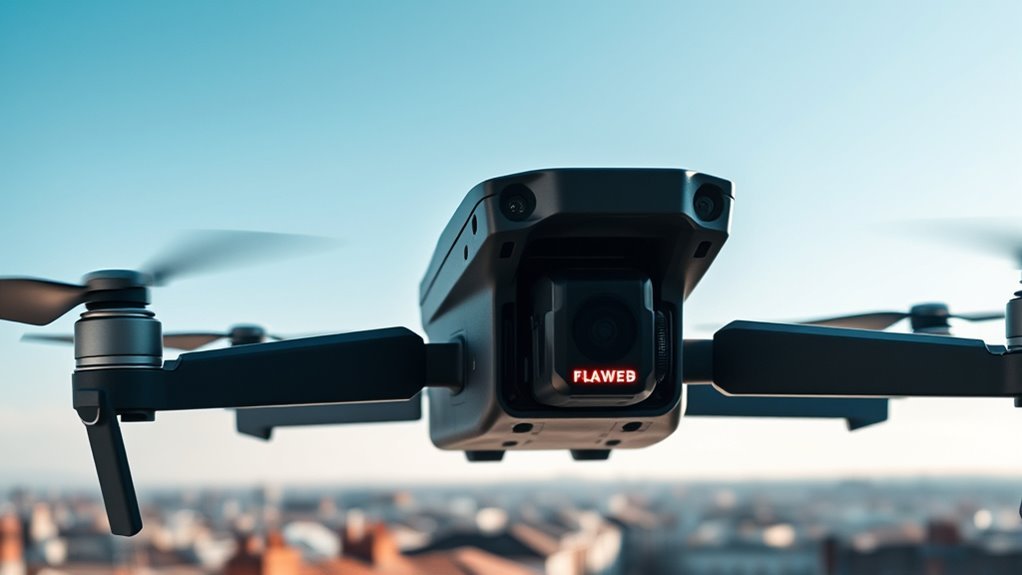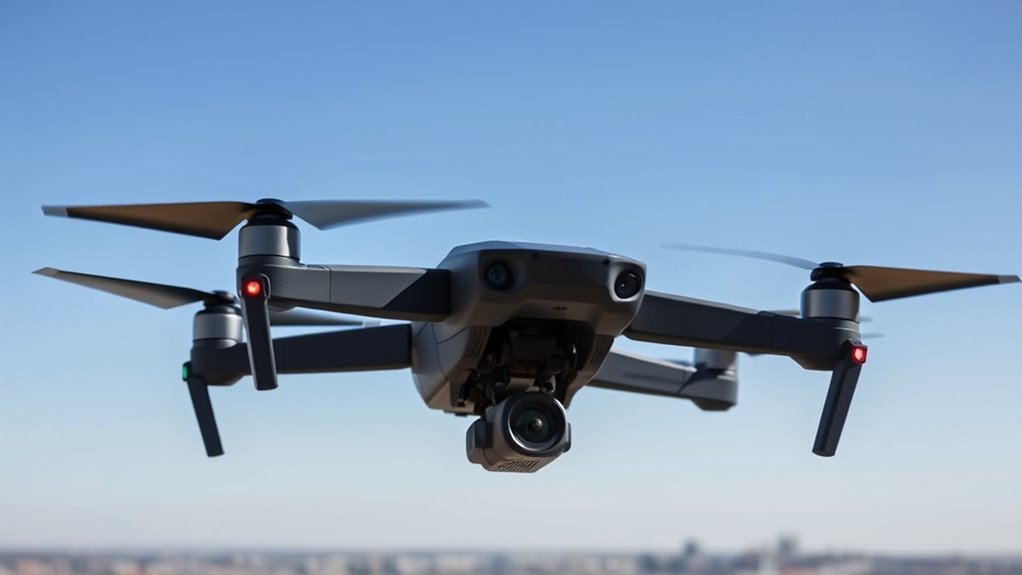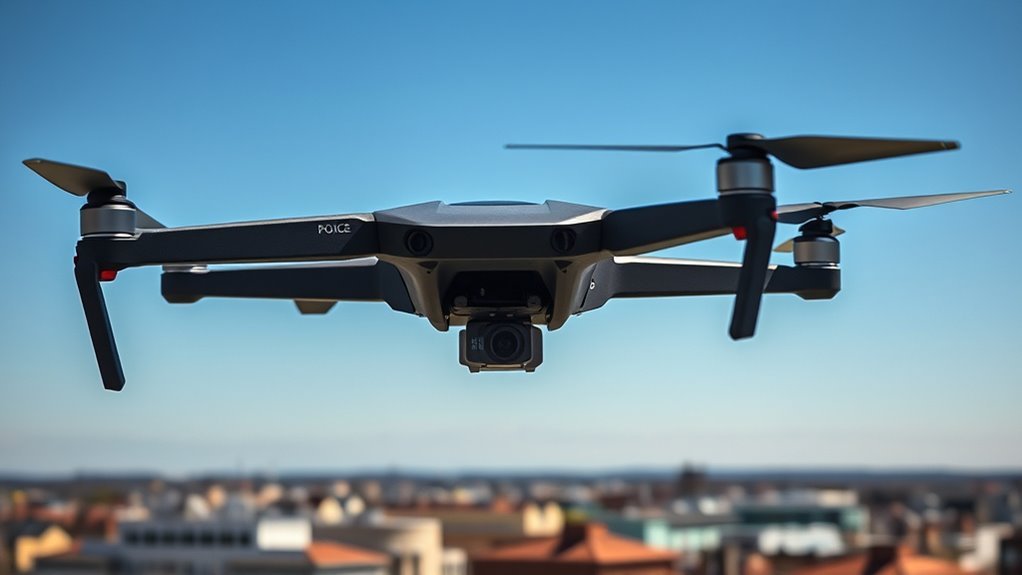Police drones utilize advanced imaging and surveillance technology, like thermal cameras and high-resolution sensors, to enhance operational efficiency. They feature robust communication systems for real-time data transmission and intuitive control interfaces. Lightweight materials and proper weight distribution guarantee peak flight performance and stability. Safety features include compliance with regulations, collision avoidance systems, and automatic return-to-home functions. This technology is continually evolving, and further exploration reveals even more innovative advancements in police drone capabilities.
Design and Build of Police Drones

When designing and building police drones, engineers focus on several vital factors to guarantee peak performance in law enforcement scenarios. One essential aspect is the choice of drone materials. Lightweight composites and advanced plastics are often preferred, as they enhance agility and extend flight duration. Proper weight distribution is another vital consideration; it guarantees stability during flight and peak maneuverability. By strategically placing components, engineers can mitigate any adverse effects from uneven weight, allowing for swift responses in critical situations. Additionally, the structural integrity of these materials must withstand various environmental conditions while remaining portable. Balancing these elements ultimately contributes to a drone’s effectiveness, enabling law enforcement to maintain public safety without compromising operational efficiency or freedom.
Imaging and Surveillance Technology

As imaging and surveillance technology evolves, police drones increasingly incorporate advanced sensors and cameras to enhance situational awareness and operational effectiveness. One significant advancement is thermal imaging, which allows you to detect heat signatures, making it invaluable for night operations and search-and-rescue missions. These drones provide aerial surveillance capabilities that can cover vast areas quickly, enabling law enforcement to monitor large crowds or track suspects with precision. High-resolution cameras now offer real-time video feeds, further enhancing the decision-making process. Additionally, Asylon’s advanced AI integration streamlines operations and improves the efficiency of police responses. Together, these technologies not only improve the efficiency of police operations but also guarantee that civil liberties are respected, as they can be deployed in a manner that minimizes unnecessary intrusion while maintaining public safety. Additionally, advanced noise filtering techniques can enhance the clarity of images captured by these drones, ensuring that critical details are not lost in low-light conditions.
Communication and Control Systems

Effective communication and control systems are fundamental for maximizing the operational capabilities of police drones. You’ll find that robust data transmission protocols allow real-time feedback and situational awareness, vital for effective remote operation. These systems typically employ advanced radio frequencies or satellite connections to guarantee a seamless flow of information. High-bandwidth links enable the quick transfer of video feeds and sensor data, allowing operators to make informed decisions on the fly. Furthermore, encryption methods protect sensitive information, making sure that only authorized personnel can access the drone’s data stream. The integration of intuitive control interfaces provides user-friendly navigation, empowering law enforcement to respond efficiently in dynamic environments while maintaining the necessary oversight needed for responsible drone deployment. Additionally, advanced features like AI-driven object recognition enhance the capabilities of these drones, improving their effectiveness in identifying potential threats during operations. Furthermore, the integration of intelligent flight modes allows for precision maneuvers, enhancing the operational effectiveness of police drones in various scenarios.
Flight Capabilities and Performance
Although the intricacies of flight capabilities and performance may vary among different police drones, several key factors consistently define their effectiveness in law enforcement operations. The payload capacity is essential, as it determines what equipment—like cameras or sensors—can be carried. Higher payload capacities enable drones to support advanced surveillance and data collection, enhancing operational effectiveness. Additionally, endurance range is important; it dictates how long a drone can stay airborne during missions. Drones with extended endurance can cover larger areas without needing to recharge or land frequently, allowing for sustained surveillance during critical incidents. Balancing these elements guarantees that police drones can respond rapidly and effectively, ultimately contributing to enhanced public safety and operational freedom within law enforcement. Furthermore, the integration of advanced electro-optical and infrared options enhances the drones’ surveillance capabilities, making them invaluable in various operational scenarios. To maximize their effectiveness, police drones often utilize high-resolution sensors that provide enhanced threat detection through clearer imagery for quicker identification.
Safety Features and Regulations
While operating police drones offers significant benefits, ensuring safety and compliance with regulations is paramount. You’ll need to implement robust safety protocols to mitigate risks associated with drone operations. This includes pre-flight checks, emergency procedures, and maintaining clear communication with ground teams. Regulatory compliance is non-negotiable; familiarize yourself with local, state, and federal laws governing drone usage. Adhering to altitude restrictions, no-fly zones, and privacy considerations is essential to avoid legal repercussions and maintain public trust. Furthermore, many drones, such as the AeroVironment Puma, utilize radar-based systems for collision avoidance, enhancing operational safety. Additionally, integrating features like geofencing, automatic return-to-home, and obstacle avoidance enhances safety. By prioritizing these elements, you not only protect individuals but also uphold the principles of freedom that underpin responsible drone usage in law enforcement. Furthermore, utilizing geofencing technology can help ensure that drones operate within designated boundaries, enhancing overall safety.
Frequently Asked Questions
How Much Do Police Drones Typically Cost?
When considering drone pricing, you’ll find police drones typically range from $1,000 to over $100,000. Budget considerations depend on features like flight time, camera quality, and operational range, which are essential for effective law enforcement applications.
What Materials Are Used in Police Drone Construction?
When considering police drone construction, you’ll find materials like carbon fiber, aluminum, and plastics are common. These drone materials enhance durability and performance, while advanced construction processes guarantee efficiency and reliability in various operational environments.
Can Police Drones Operate in Adverse Weather Conditions?
Yes, police drones can operate in adverse weather conditions, though their performance may vary. Weather resilience features, such as enhanced stabilization and waterproofing, improve functionality, ensuring effective operations even during rain, fog, or strong winds.
How Are Police Drones Maintained and Serviced?
To guarantee peak performance, you’ll need to conduct regular drone inspections and adhere to established maintenance protocols. This includes checking battery life, camera functionality, and software updates, keeping your drone ready for any operational demands.
What Are the Ethical Concerns Surrounding Police Drone Usage?
When considering police drones, you can’t ignore the ethical concerns. They raise significant privacy implications and potential surveillance overreach, challenging your freedom while balancing public safety needs against individual rights in an increasingly monitored society.

